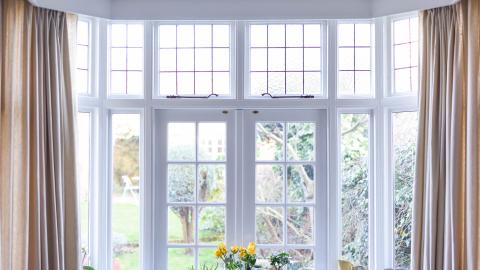
Q:Are new low-e window films an attractive measure for demand-side management (DSM) programs?
A:New, advanced window films that incorporate low-e coating are superior to traditional window film technology in two ways.
First, they reduce cooling loads by reflecting radiant energy, much like conventional films, but block much less visible light. Second, unlike conventional films, they let less heat escape from the building. Research done by the Lawrence Berkeley National Laboratory (LBNL) shows that although these new window films are more expensive than their predecessors, they are still sufficiently inexpensive to be cost-effective in many locations and applications. As a result, they represent an attractive means to reduce losses through single-pane windows. In some locations and applications, it is even cost-effective to apply them to clear double-pane windows.
The pain of single-pane windows
Although multipane windows have been on the market for a long time, there are still quite a few single-pane windows out in the building stock. In the US West, according to estimates from the US Department of Energy, 34% of residential buildings (by area) and 40% of commercial buildings (again by area) feature single-pane windows. These windows exhibit such poor performance that more heat in that region is lost through single-pane windows than through all the multipane windows combined.
The key obstacle to window replacement is the high cost of new multipane windows.
Several solutions to this problem have shown moderate success. The best solution is to replace single-pane windows with new multipane windows, but that’s only happening at a rate of about 2% per year. The key obstacle to window replacement is the high cost of new multipane windows. Installing interior storm windows is another solution, but their uptake is limited by two key objections: They obstruct window operation when in place and take up storage space when not in place. Some programs have tried applying window film, but until recently, it only reduced cooling season energy consumption, and customers didn’t like how dark it made interior spaces. New, advanced low-e window films, however, address both of those shortcomings.
Two reasons low-e window films are better
Low-e window films contain a room-side low-e coating, which enables them to achieve two characteristics that distinguish them from older window film products. They feature a visible light transmittance (Tvis) to solar heat gain coefficient (SHGC) ratio of about 1.3. That’s an improvement on both single-pane glass as well as old-style window film without low-e, both of which feature a Tvis/SHGC ratio of about 1.1. It enables the new low-e films to reduce cooling loads as much as the old films, while allowing more visible light in. In addition, the low-e films cut heat loss by about 40% compared to single-pane glass, with or without the old-style window film applied. These values are for the center of the glass only, and window units with frames will perform a bit differently. We’re aware of only two manufacturers that produce low-e window film to these specifications: Eastman Chemical and 3M.
LBNL research suggests that low-e window films have the potential to mitigate an important area of energy waste.
Low-e window films can be cost-effective in a variety of applications. In tests and simulations done by LBNL, outlined in the Green Proving Ground report Low-e Applied Film Window Retrofit for Insulation and Solar Control (PDF), researchers found that low-e films yielded relatively low simple payback periods. For example, based on a simulation they did, these researchers concluded that if VT35 window film was applied to single-pane clear glass in a commercial building in Minneapolis, it would yield a 4.1-year simple payback period based on heating and cooling season savings. This research suggests that low-e window films have the potential to mitigate an important area of energy waste.